Beginners Guides
Cold Air Return in Basement
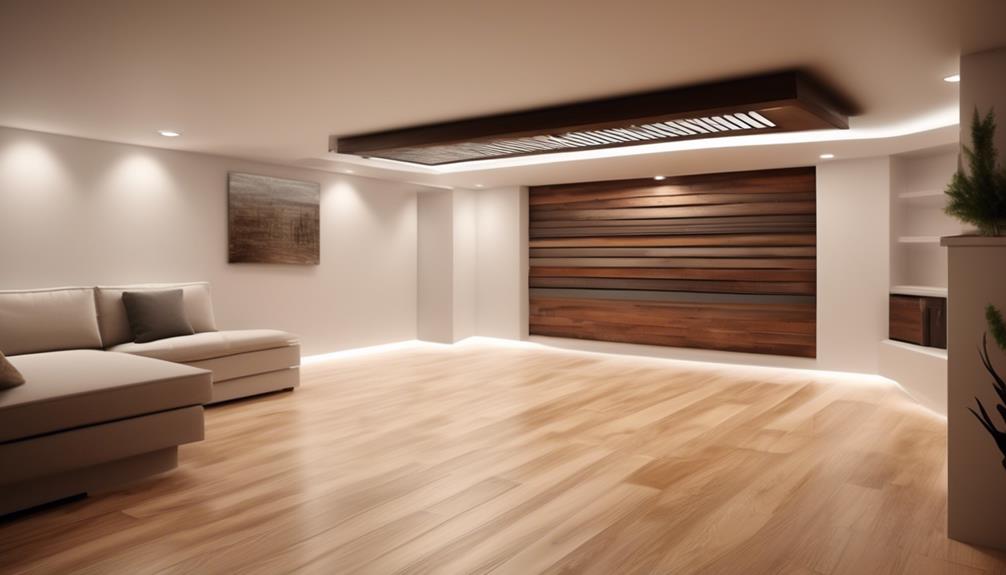
We've all experienced the chill of a basement that feels more like a refrigerator than a livable space, and one common concern is that adding a cold air return will only exacerbate this issue.
However, when properly installed and maintained, a cold air return can actually improve the comfort and air quality of your basement.
But how exactly does it work, and what are the specific benefits of having one in your basement?
Let's explore the ins and outs of cold air returns and how they can make your basement a more inviting and comfortable space.
Key Takeaways
- Cold air returns are crucial for maintaining proper air circulation and temperature control in basements.
- They prevent basements from becoming damp and musty by drawing in cooler air from the basement.
- Cold air returns regulate temperature and prevent moisture buildup, contributing to improved air quality and a healthier living environment.
- Proper installation, maintenance, and care of cold air return systems maximize their effectiveness and enhance energy efficiency.
Importance of Cold Air Returns in Basements
In a basement, cold air returns are crucial for maintaining proper air circulation and temperature control. Basement ventilation is often limited, and without proper air circulation, basements can become damp and musty. Cold air returns play a vital role in combating these issues by allowing the circulation of air throughout the space.
When warm air rises, it creates a pressure difference that draws in cooler air from the basement through the cold air returns. This process helps to regulate the temperature and prevent the buildup of moisture, ultimately contributing to a more comfortable and healthier basement environment.
Effective air circulation is essential for preventing stagnant air, which can lead to mold and mildew growth. Cold air returns facilitate the movement of air, preventing it from becoming trapped in the basement. Additionally, they help in distributing heat evenly throughout the space when the heating system is in use.
Proper air circulation also aids in reducing the workload on the HVAC system, leading to improved energy efficiency. Therefore, ensuring the presence and functionality of cold air returns is integral for maintaining a well-ventilated and comfortable basement environment.
Benefits of Installing a Cold Air Return

Installing a cold air return enhances basement ventilation and contributes to improved air quality and temperature regulation. The benefits of installing a cold air return include:
- Improved Energy Efficiency: By installing a cold air return in the basement, the overall energy efficiency of the HVAC system is enhanced. This is achieved by ensuring that the system can effectively circulate and distribute air throughout the basement, leading to more efficient heating and cooling.
- Cost Savings: With improved energy efficiency comes cost savings. Proper ventilation and air distribution facilitated by a cold air return can lead to lower energy bills due to optimized heating and cooling processes.
- Enhanced Air Quality: A cold air return helps in the circulation of air, preventing stagnation and promoting the removal of stale air, dust, and pollutants. This results in improved air quality throughout the basement, creating a healthier and more comfortable living environment.
Factors to Consider for Cold Air Return Installation
Consider the basement layout and existing HVAC system when determining the optimal location for the cold air return. The installation location should be strategically chosen to ensure efficient airflow and temperature distribution throughout the basement. Additionally, sizing considerations are crucial to ensure that the cold air return is adequately sized to accommodate the airflow requirements of the space. Below is a table outlining key factors to consider for cold air return installation:
| Factors to Consider | Details |
|---|---|
| Installation Location | Place the cold air return in a central location to allow for even distribution of air throughout the basement. Ensure it is not obstructed by furniture or other obstructions. |
| Sizing Considerations | Calculate the required CFM (cubic feet per minute) for the basement space to determine the appropriate size for the cold air return. Consider the size of the return grille and ductwork to ensure proper airflow.
Tips for Maximizing Cold Air Return Effectiveness
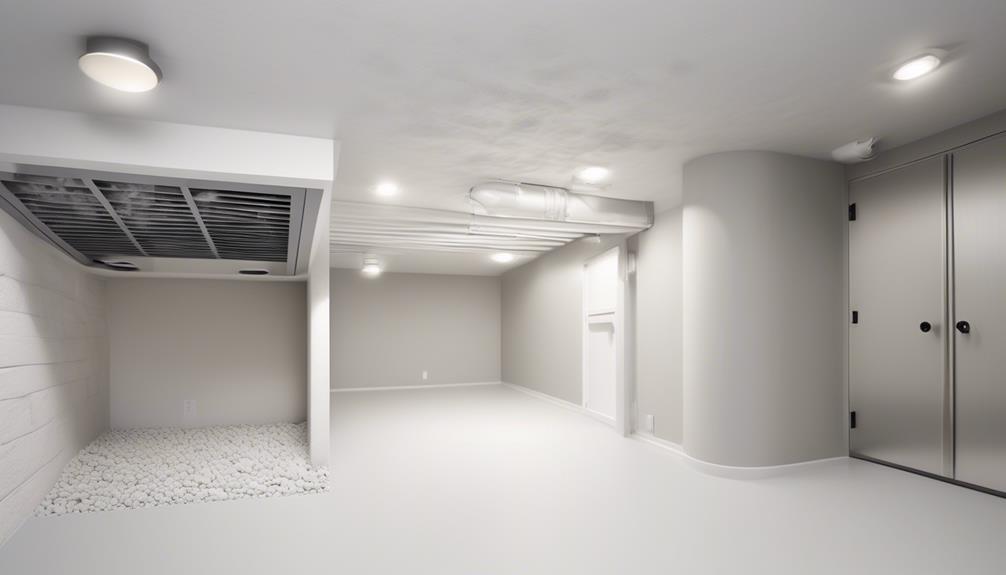
Maximizing the effectiveness of the cold air return involves strategically placing the return in a central location to ensure even airflow throughout the basement, while also ensuring it's unobstructed.
To maximize the effectiveness of the cold air return in your basement and ensure proper air circulation, consider the following tips:
- Seal Duct Leaks: Inspect the ductwork for any leaks and seal them properly. Leaks can lead to loss of air pressure and reduce the efficiency of the system, impacting overall air circulation in the basement.
- Use High-Quality Filters: Opt for high-quality air filters to trap dust, debris, and allergens effectively. This not only enhances air quality but also prevents the accumulation of particles that can obstruct airflow through the cold air return.
- Regular Maintenance: Schedule regular maintenance for your HVAC system to keep it running at its best. This includes cleaning or replacing filters, checking for blockages, and ensuring the system operates at optimal energy efficiency.
Maintenance and Care for Cold Air Return Systems
Ensuring regular maintenance and care for cold air return systems is crucial for optimizing their performance and extending their lifespan. Dust prevention is key to maintaining the efficiency of the system. Regularly changing or cleaning the air filters is essential to prevent dust and debris buildup, which can hinder airflow and reduce the system's effectiveness. Cleaning the vents and ductwork with a vacuum or duster can also help prevent dust accumulation.
In addition to dust prevention, proper insulation is vital for enhancing energy efficiency. Ensuring that the ductwork is well-insulated can prevent heat loss in the winter and heat gain in the summer, reducing the workload on the system and lowering energy costs. Options for insulation include foil-backed foam board, fiberglass insulation, or spray foam insulation. Properly insulating the ductwork can also help maintain a consistent temperature throughout the home.
Regular maintenance and care for cold air return systems not only optimize their performance but also contribute to energy efficiency and cost savings. By implementing dust prevention and insulation techniques, homeowners can ensure that their systems operate effectively and efficiently.
Frequently Asked Questions
Can I Install a Cold Air Return in My Basement if I Already Have a Heating and Cooling System in Place?
Yes, you can install a cold air return in your basement even if you already have a heating and cooling system in place. It's essential to ensure the proper size and location of the cold air return to optimize basement ventilation and maintain energy efficiency.
Additionally, incorporating a cold air return can make you eligible for energy efficiency incentives. It's a technical process, but with the right expertise, it can enhance the effectiveness of your existing HVAC system.
Are There Any Specific Building Codes or Regulations I Need to Be Aware of When Installing a Cold Air Return in My Basement?
Building codes for cold air return installation vary by location. Compliance with these codes is crucial to ensure safety and efficiency. Prior to installation, researching local building codes and regulations is essential.
Installation requirements may include specific duct size, clearances from combustible materials, and proper sealing to prevent air leakage. Professional advice and permits may be necessary to adhere to these codes and ensure a successful installation.
What Are Some Common Mistakes to Avoid When Installing a Cold Air Return in a Basement?
When installing a cold air return in a basement, it's crucial to avoid common mistakes. Proper sizing ensures efficient airflow, preventing strain on the HVAC system. Improper installation can lead to air leaks and reduced efficiency.
Airflow direction must be carefully considered to prevent recirculating cold air. It's essential to consult building codes and regulations to ensure compliance.
Professional installation and regular maintenance are key to a well-functioning cold air return system.
Are There Any Energy Efficiency Incentives or Rebates Available for Installing a Cold Air Return in My Basement?
We've found that there are various energy efficiency incentives and rebates available for implementing cold air returns in basements. These incentives aim to promote energy conservation and may include financial benefits such as tax credits or utility rebates.
It's crucial to conduct a cost-benefit analysis to determine the potential savings and the installation process. This technical approach helps ensure the best outcome for energy efficiency and financial gains.
How Can I Determine the Right Size and Location for a Cold Air Return in My Basement?
To determine the right size and location for a cold air return, we consider airflow requirements, ensuring optimal performance. The benefits include improved air circulation and more efficient heating and cooling.
We assess the size based on the volume of the area it serves and position it strategically to maximize airflow. These considerations optimize the system's efficiency and ensure a balanced temperature throughout the space.
Should I Be Concerned About the Cold Air Return in My Basement If I Notice Signs That a Ceiling Fan Might Fall?
If you notice warning signs of falling for your ceiling fan in the basement, it’s important to address the issue as soon as possible. While the cold air return in the basement may not be directly related to the fan’s stability, it’s still crucial to ensure all components are properly maintained.
Conclusion
So, as we've learned, cold air returns are essential for basement ventilation and comfort.
While it may seem ironic that 'cold' air is actually beneficial, it's important to remember that proper airflow is key to maintaining a healthy and comfortable living space.
By following the tips and considering the factors we've discussed, you can maximize the effectiveness of your cold air return system and ensure a well-ventilated basement.
- About the Author
- Latest Posts
Introducing Ron, the home decor aficionado at ByRetreat, whose passion for creating beautiful and inviting spaces is at the heart of his work. With his deep knowledge of home decor and his innate sense of style, Ron brings a wealth of expertise and a keen eye for detail to the ByRetreat team.
Ron’s love for home decor goes beyond aesthetics; he understands that our surroundings play a significant role in our overall well-being and productivity. With this in mind, Ron is dedicated to transforming remote workspaces into havens of comfort, functionality, and beauty.
Beginners Guides
The Evolution of Cruise Ship Amenities and Design: A How-To Guide
Luxuriate in the evolution of cruise ship amenities and design, discovering the secrets behind the transformation that will leave you yearning for more.
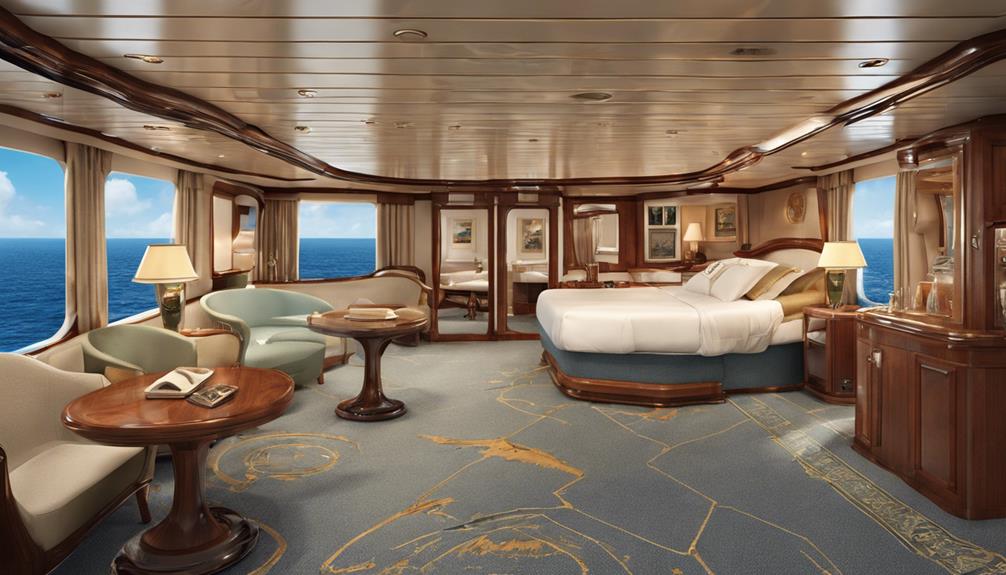
As we set sail through the intricate web of cruise ship evolution, we navigate the waters of design and amenities like seasoned captains. From the humble beginnings of passenger spaces to the grandeur of modern luxury liners, the journey unfolds with each wave of innovation.
Join us as we uncover the secrets behind the transformation of cruise ship experiences, offering a glimpse into the future of seafaring splendor.
Key Takeaways
- Cruise ship amenities have evolved to offer upscale dining, entertainment, and relaxation options.
- Technological advancements enhance passenger comfort and provide a seamless cruising experience.
- Modern mega-ships feature expansive shopping, fitness, spa, and entertainment facilities for a luxurious stay.
- Embracing sustainable practices is a growing trend among cruise companies to promote eco-friendly operations.
Historical Roots of Cruise Ship Design
The evolution of cruise ship design can be traced back to the early 19th century when packet ships first introduced dedicated passenger spaces in 1818. This marked a significant shift in maritime travel, where the focus began to shift towards providing comfortable accommodations for travelers.
As time progressed, the design of ocean liners evolved, with pioneers like Albert Ballin introducing luxury elements in the early 1890s. This set the stage for opulent cruise ship design, with a growing emphasis on amenities and passenger comfort.
One notable example of this evolution was Cunard's Queen Mary, which debuted in 1934 showcasing elegant Art Deco features. The ship's interior design influenced future cruise ships, inspiring a trend towards more sophisticated and stylish aesthetics.
As the demand for luxury travel grew in the early 1900s, ship designs became increasingly opulent, with a focus on attracting passengers through lavish amenities and elegant surroundings. German modernism in the 1930s also played a role in shaping cruise ship aesthetics, incorporating sleek and modern elements into the design to create a unique and luxurious experience on the high seas.
Emergence of Luxurious Onboard Amenities

With the rise of modern cruise ship construction techniques and evolving consumer demands, a new era of onboard luxury amenities has emerged to redefine the passenger experience at sea. Cruise ships now boast a plethora of upscale offerings, from extravagant restaurants helmed by renowned chefs to chic bars and restaurants serving exotic cocktails and gourmet cuisine. These onboard amenities cater to the diverse tastes of passengers, providing a sophisticated dining experience that rivals top establishments on land.
In addition to fine dining options, cruise ships have also transformed their public areas into luxurious spaces designed for relaxation and entertainment. Lavish lounges, stylish theaters, and upscale shopping boutiques offer passengers a range of activities to indulge in during their voyage. Whether seeking a tranquil retreat or a vibrant social scene, these amenities and entertainment options ensure that passengers have a memorable and indulgent experience while at sea. The evolution of onboard amenities has elevated the cruise ship experience, allowing travelers to enjoy the height of luxury while exploring the world's oceans.
Technological Innovations in Cruise Ships
Amidst the evolution of cruise ship amenities towards luxurious onboard experiences, the integration of technological innovations has revolutionized the industry's approach to enhancing passenger comfort and entertainment. Modern cruise lines have embraced cutting-edge technologies to create a seamless and enjoyable experience for travelers.
- Diesel-Electric Propulsion Systems: Cruise ships now utilize advanced diesel-electric propulsion systems to enhance fuel efficiency and overall performance. These systems not only reduce environmental impact but also provide a smoother sailing experience for passengers.
- Stabilizer Systems: To combat the discomfort caused by rough seas, cruise ships have incorporated stabilizer systems. These systems work to stabilize the vessel, ensuring a more comfortable journey for guests, even in challenging maritime conditions.
- Interactive Entertainment: Modern cruise ships are designed specifically to offer a wide range of entertainment options, including gourmet restaurants, shopping malls, and even casinos. These interactive amenities provide passengers with a luxurious onboard experience, turning the cruise ship into a destination in itself.
Evolution of Modern Mega-Ship Features

Exploring the waters of the cruise industry's evolution, one cannot overlook the grand transformation in the features of modern mega-ships. These floating cities on the ocean have redefined cruise ship design by offering an array of amenities that cater to every passenger's desires. From expansive shopping arcades to cutting-edge gyms, tranquil spa centers, and lively nightclubs, modern mega-ships provide passengers with an unparalleled onboard experience.
Below is a table highlighting the evolution of modern mega-ship features:
| Feature | Description |
|---|---|
| Expansive Shopping Arcades | Offering a wide range of retail options for passengers to indulge in some retail therapy at sea. |
| Cutting-Edge Gyms | Equipped with state-of-the-art fitness facilities, ensuring passengers can maintain their workout routines. |
| Tranquil Spa Centers | Providing relaxation and rejuvenation with a variety of spa treatments and wellness activities. |
| Lively Nightclubs | Offering vibrant nightlife experiences with live music, dancing, and entertainment into the late hours. |
| Diverse Entertainment Options | From rock climbing to wine-tasting to Broadway-style shows, there's something for everyone onboard. |
Embracing Sustainable Practices for Cruising
Embracing sustainable practices for cruising has become a pivotal focus for many cruise companies, driving significant shifts towards eco-friendly technologies and designs. The cruise industry is actively incorporating responsible environmental practices to minimize its impact on the planet.
Here are three key ways in which the industry is embracing sustainability:
- Integration of Eco-Friendly Technologies: Many cruise companies are investing in eco-friendly technologies such as solar panels and alternative fuels to reduce emissions and promote cleaner operations onboard. These innovations not only benefit the environment but also enhance the overall cruising experience for passengers.
- Incorporation of Sustainable Design: Newer cruise ships are being designed with sustainability in mind, incorporating features that conserve energy and reduce waste. From advanced waste management systems to energy-efficient lighting, sustainable design elements are becoming standard in modern cruise ship amenities.
- Promotion of Responsible Environmental Practices: The commitment to sustainability isn't just a trend but a necessity for the long-term success and reputation of the cruise industry. By promoting responsible environmental practices, cruise companies are shaping the future of cruising towards a more environmentally conscious and sustainable approach.
Conclusion
As we reflect on the evolution of cruise ship amenities and design, we're reminded of the juxtaposition between the historical roots of simplicity and the modern era of extravagance.
From the emergence of luxurious onboard amenities to the embrace of sustainable practices, the cruise industry has continuously evolved to meet the changing needs and desires of passengers.
With each technological innovation and architectural enhancement, we see a blend of tradition and progress shaping the future of cruising.
- About the Author
- Latest Posts
Introducing Ron, the home decor aficionado at ByRetreat, whose passion for creating beautiful and inviting spaces is at the heart of his work. With his deep knowledge of home decor and his innate sense of style, Ron brings a wealth of expertise and a keen eye for detail to the ByRetreat team.
Ron’s love for home decor goes beyond aesthetics; he understands that our surroundings play a significant role in our overall well-being and productivity. With this in mind, Ron is dedicated to transforming remote workspaces into havens of comfort, functionality, and beauty.
Beginners Guides
Best Time of Year to Go on an Alaskan Cruise
When is the best time to embark on an Alaskan cruise? Let's uncover the seasonal secrets that can transform your journey.
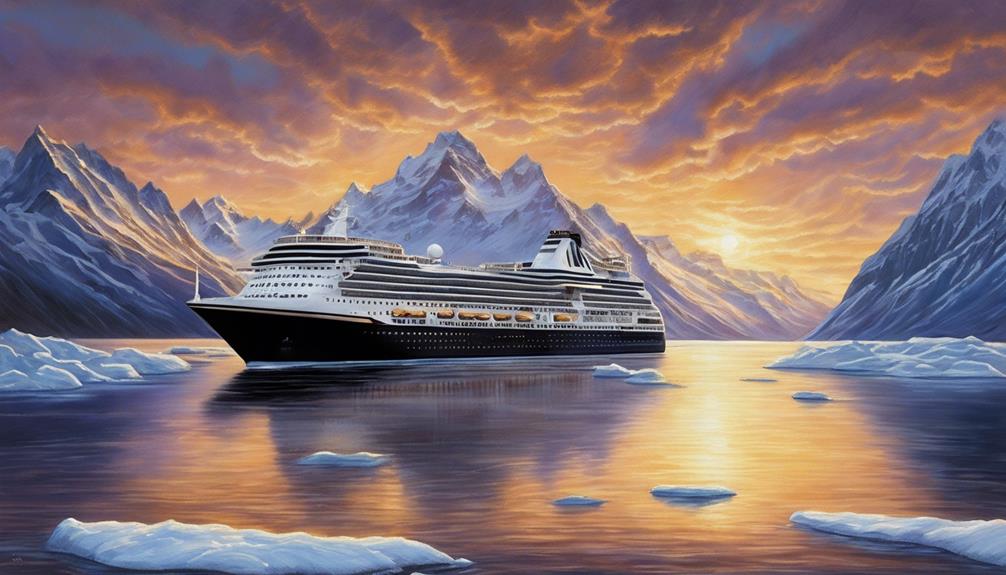
When considering the best time of year for an Alaskan cruise, you might not be aware that the season can greatly impact your experience.
From the best moments for wildlife sightings to the chance to witness the elusive Northern Lights, each period offers unique advantages.
Understanding the nuances of timing can truly enhance your Alaskan adventure and make sure you get the most out of your cruise.
Key Takeaways
- Late-May to mid-June: optimal for vibrant wildlife observation during peak salmon runs.
- Mid-June to August: best for comfortable weather, outdoor activities, and Alaskan cruise start.
- Early September: tranquil ambiance with fewer crowds, ideal for serene wildlife encounters.
- Late September: prime time for Northern Lights viewing, offering intense and colorful displays in Alaska.
Ideal Months for Alaskan Wildlife
Late-May to mid-June offers the best opportunity for observing vibrant Alaskan wildlife due to the peak of salmon runs and the presence of mothers with their calves/cubs. This period marks the awakening of wildlife in Alaska, with moose, sheep, mountain goats, and black bears becoming visible as they emerge in search of food and mating opportunities amidst the new vegetation. The cooler temperatures during late May to mid-June create a comfortable environment for wildlife excursions, allowing for longer and more enjoyable wildlife viewing experiences.
Additionally, the reduced number of tourists during this time provides a more intimate and authentic Alaskan wildlife encounter. With more daylight hours available, visitors have ample time to witness the diverse wildlife activities that unfold during these months. The vibrancy of the wildlife scene, coupled with the lush greenery of the new vegetation, sets the stage for an unforgettable Alaskan wildlife adventure that showcases the true beauty and wilderness of this spectacular region.
Optimal Time for Good Weather
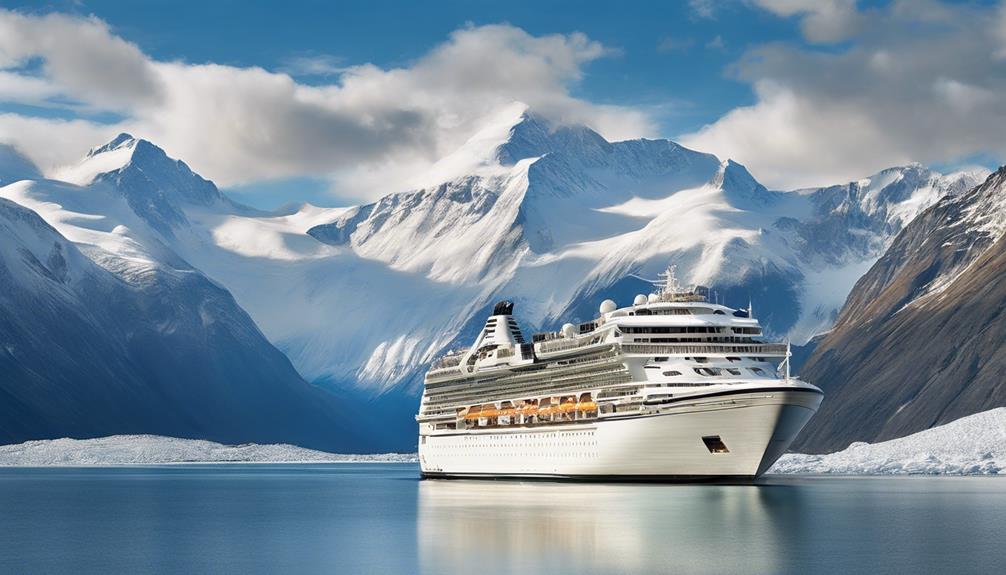
As we move into the discussion on the best time for good weather in Alaska, mid-June to August stands out as the recommended period for starting on an Alaskan cruise due to the warm temperatures and extended daylight hours. During this time, temperatures range from 50-70°F, creating pleasant conditions for outdoor activities and wildlife sightings. The long days with up to 22 hours of sunlight provide ample time for cruising and exploring the breathtaking landscapes of Alaska. Common wildlife sightings in mid-summer include brown bears, moose, beluga and humpback whales, orcas, seals, and dolphins. Choosing to cruise in mid-June to August ensures an optimal experience with comfortable weather conditions, perfect for enjoying all that Alaska has to offer.
| Weather | Best |
|---|---|
| Temperature | 50-70°F |
| Daylight Hours | Up to 22 hours |
| Wildlife | Brown bears, moose, belugas, humpbacks, orcas, seals, dolphins |
| Activities | Cruising, exploring, wildlife spotting |
| Experience | Pleasant weather, ideal for outdoor adventures |
Prime Season to Avoid Crowds
To maximize your Alaskan cruise experience with fewer crowds and a peaceful ambiance, consider starting on your journey in early September. This time offers a perfect blend of cooler temperatures, stunning fall foliage, and wildlife spectacles.
Imagine witnessing humpback whales breaching, salmon spawning, and caribou gracefully migrating in tranquil waters, away from the summer crowds. Early September marks a shift period in Alaska, where nature prepares for autumn, creating serene surroundings ideal for an intimate cruise experience.
The reduced tourist congestion during this time allows for a more personal connection with the breathtaking landscapes and wildlife encounters. Picture yourself enjoying the Alaskan wilderness in a quieter setting, appreciating the beauty and majesty of this unique destination without the hustle and bustle of peak season.
Embrace the opportunity for a peaceful and unforgettable journey through Alaska's waters during early September.
Best Time for Northern Lights

For best viewing of the mesmerizing Northern Lights in Alaska, consider planning your trip for late September. This time of year offers ideal conditions to witness the dancing lights in the Arctic Sky, creating a truly mesmerizing phenomenon.
Here are four reasons why late September is the best time for experiencing the Northern Lights in Alaska:
- Solar Activity Peaks: Late September sees an increase in solar activity, leading to more intense and vibrant displays of the Northern Lights.
- Solar Wind Particles: During this time, solar wind particles collide with air molecules, producing stunning colors that light up the night sky.
- Great Viewing Opportunities: Alaska provides excellent viewing opportunities for those seeking to marvel at the beauty of the Northern Lights.
- Unforgettable Experience: Immerse yourself in the magic of the Northern Lights as they paint the sky with their enchanting glow during late September.
Recommended Time for Glacier Viewing
The prime time for experiencing the awe-inspiring beauty of Alaska's glaciers is during the warm summer months of June, July, and August. This period aligns with the peak cruise season, offering ideal conditions for glacier viewing. During summer, glaciers are at their most active and dynamic state, showcasing spectacular calving events and intricate ice formations. The longer daylight hours in the summer months provide ample opportunities for extended glacier exploration, allowing you to witness the dynamic nature of these icy wonders.
When planning your Alaskan cruise adventure, be sure to select a cruise itinerary that includes glacier viewing as a highlight. This guarantees that you won't miss out on the opportunity to witness these natural marvels up close. Seeing glaciers in person is a truly unforgettable experience, offering a glimpse into the raw power and beauty of these majestic ice formations. Prepare to be mesmerized by the sight of dynamic glaciers during your Alaskan cruise, creating memories that will last a lifetime.
Conclusion
To sum up, no matter what time of year you choose to go on an Alaskan cruise, you're guaranteed to have a memorable experience.
Did you know that Alaska has over 100,000 glaciers, covering about 29,000 square miles of the state?
With each season offering its own unique attractions, there's something for everyone to enjoy on an Alaskan cruise.
So pack your bags and get ready for an adventure of a lifetime!
- About the Author
- Latest Posts
Introducing Ron, the home decor aficionado at ByRetreat, whose passion for creating beautiful and inviting spaces is at the heart of his work. With his deep knowledge of home decor and his innate sense of style, Ron brings a wealth of expertise and a keen eye for detail to the ByRetreat team.
Ron’s love for home decor goes beyond aesthetics; he understands that our surroundings play a significant role in our overall well-being and productivity. With this in mind, Ron is dedicated to transforming remote workspaces into havens of comfort, functionality, and beauty.
Beginners Guides
Uncover Rich Mediterranean Cultures on Silversea's Grand Voyage: A History Guide
Yield to the allure of the Mediterranean's historical tapestry on Silversea's Grand Voyage – where hidden stories await to be unveiled.
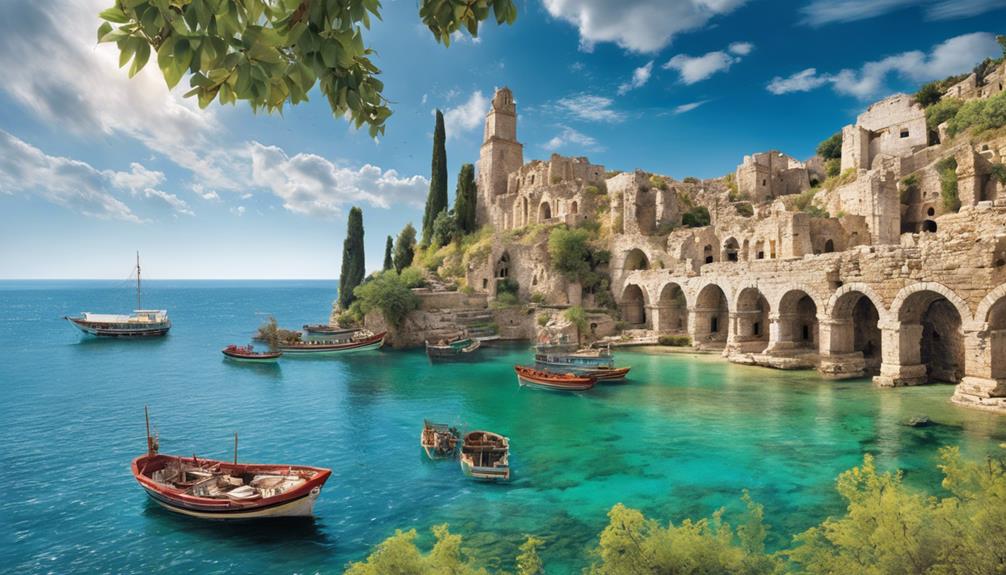
While the idea of exploring the rich Mediterranean cultures with Silversea's Grand Voyage might seem like a well-trodden path, the depth and intricacies of this historical journey are bound to surprise even the most seasoned travelers.
Discover not just the famous landmarks, but the hidden gems and untold stories waiting to be uncovered along this immersive voyage.
From the whispers of ancient civilizations to the echoes of diverse traditions, there is something remarkable about the Mediterranean that beckons us to investigate further into its enthralling past.
Key Takeaways
- Explore ancient wonders and civilizations like Acropolis and Colosseum.
- Immerse in diverse cultural encounters in historic cities along the voyage.
- Witness the enduring legacy of Mediterranean civilizations on modern society.
- Unveil the richness of Mediterranean cultures through art, cuisine, and traditions.
Mediterranean Heritage and Civilization Highlights
Exploring the Mediterranean Heritage and Civilization Highlights reveals a tapestry woven with the threads of ancient empires, cultural exchanges, and enduring legacies. The Mediterranean region boasts a rich heritage stemming from illustrious ancient civilizations like the Greeks, Romans, Phoenicians, and Egyptians. These civilizations have left an indelible mark on history, with key historical sites such as the Acropolis in Athens, the Colosseum in Rome, the Pyramids of Giza in Egypt, and the ancient city of Carthage in Tunisia standing as affirmations to their grandeur.
Being a crossroads of cultures, the Mediterranean has been a melting pot of diverse influences, resulting in a vibrant tapestry of art, architecture, cuisine, and traditions. The region's history is punctuated by significant events such as the rise and fall of empires, the propagation of religions like Christianity and Islam, and the evolution of democratic ideals. The lasting legacy of Mediterranean civilizations can be seen in the shaping of Western civilization through contributions in philosophy, literature, science, and governance.
Silversea's Grand Voyage Itinerary Insights
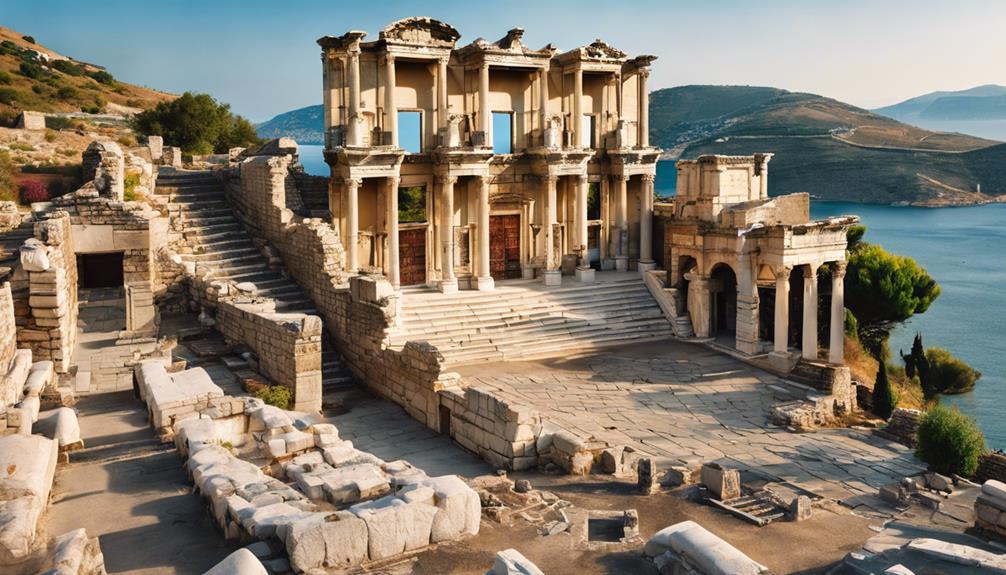
Starting on Silversea's Grand Voyage through the Mediterranean reveals a curated journey steeped in rich cultural experiences and historical marvels waiting to be explored. The itinerary is carefully crafted to immerse travelers in the diverse landscapes and ancient landmarks of the region. Below is a table highlighting some of the key insights into what guests can expect on this extraordinary voyage:
| Experience | Destination | Highlights |
|---|---|---|
| Iconic Sites | Athens, Rome | Acropolis, Colosseum |
| Historic Treasures | Ephesus, Valletta | Ancient city, UNESCO World Heritage Site |
| Cultural Immersion | Istanbul, Jerusalem | Diverse cultures, Excursions to iconic landmarks |
| Rich Heritage Exploration | Naples, Malta | Pyramids of Giza, Mediterranean history exploration |
Silversea's Grand Voyage offers a blend of history, culture, and adventure, making it an unforgettable journey for those seeking to uncover the wonders of the Mediterranean.
Ancient Wonders of the Mediterranean Revealed
As we set sail on a journey through the Mediterranean's historical tapestry, the ancient wonders of this region reveal an enthralling narrative of civilization and legacy.
Ancient Wonders of the Mediterranean:
- Iconic Sites: Explore the past by discovering renowned landmarks like the Acropolis in Athens and the Colosseum in Rome, witnessing firsthand the architectural marvels that have withstood the test of time.
- Guided Tours and Insights: Begin on guided tours offering expert insights into the rich history and cultural heritage of the Mediterranean, providing a deeper understanding of the civilizations that once flourished along these shores, from the Phoenicians to the Romans.
- Art, Architecture, and Mythology: Immerse yourself in the art, architecture, and mythology of ancient Mediterranean civilizations, gaining a profound appreciation for their influence on modern society and the enduring legacy they've left behind.
Embark on a voyage that not only traverses the seas but also journeys through the annals of time, unraveling the enthralling stories woven into the fabric of the Mediterranean's ancient wonders.
Cultural Encounters Along the Grand Voyage
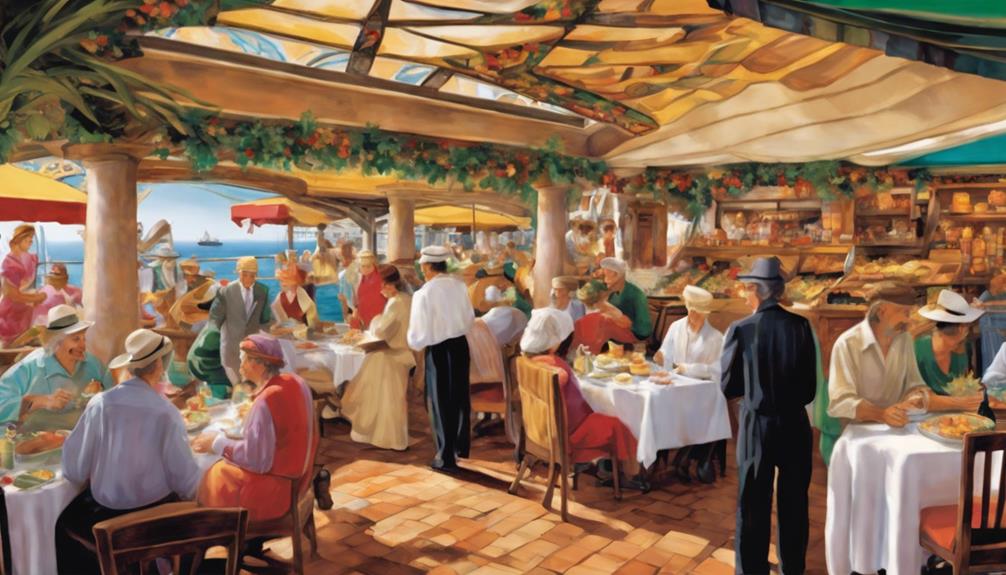
Starting on the grand voyage through the Mediterranean, we investigate a mosaic of cultural encounters that offer a rich tapestry of history and traditions waiting to be explored.
From the historic cities of Venice, Istanbul, and Barcelona to the ancient ruins in Greece such as the Acropolis in Athens and the Palace of Knossos in Crete, each stop along the journey presents a unique opportunity for cultural immersion.
In Malta, travelers can engage with local traditions and savor the distinctive cuisine that reflects a blend of Mediterranean and North African influences. Egypt beckons with its iconic sites like the Pyramids of Giza and the Sphinx, inviting us to explore its rich history.
Croatia, with its diverse cultural heritage ranging from Roman ruins to medieval architecture in cities like Dubrovnik, provides a glimpse into the intricate tapestry of Mediterranean cultures waiting to be unravelled. Each encounter promises a deeper understanding and appreciation of the region's vibrant and multifaceted identity.
Unveiling the Diversity of Mediterranean Cultures
Diving into the depths of the Mediterranean tapestry, we uncover a myriad of cultures that intertwine to create a rich and diverse mosaic of traditions and histories. The Mediterranean region, encompassing countries like Italy, Greece, Spain, Turkey, and Egypt, boasts a cultural extravaganza unlike any other.
Here's a glimpse into the kaleidoscope of Mediterranean cultures:
- Italy: Indulge in the sumptuous flavors of Italian cuisine, explore ancient Roman ruins, and witness the grandeur of Renaissance art in cities like Rome, Florence, and Venice.
- Greece: Immerse yourself in the birthplace of democracy and philosophy, savor traditional Greek dishes like moussaka and souvlaki, and marvel at iconic landmarks such as the Acropolis and Delphi.
- Spain: Experience the passion of flamenco, taste authentic paella, and wander through historic sites like the Alhambra in Granada and the Sagrada Familia in Barcelona.
These Mediterranean cultures offer a treasure trove of traditions, culinary delights, historical landmarks, and vibrant festivals waiting to be explored.
Conclusion
As we conclude our journey through the Mediterranean with Silversea's Grand Voyage, we've unraveled the intricate tapestry of cultures that define this historic region. From the ancient wonders of Italy and Greece to the vibrant markets of Turkey and the picturesque islands of Malta and Crete, we've witnessed the rich diversity that makes the Mediterranean a treasure trove of heritage and civilization.
Our exploration has confirmed that the Mediterranean truly is a melting pot of cultures waiting to be discovered.
- About the Author
- Latest Posts
Introducing Ron, the home decor aficionado at ByRetreat, whose passion for creating beautiful and inviting spaces is at the heart of his work. With his deep knowledge of home decor and his innate sense of style, Ron brings a wealth of expertise and a keen eye for detail to the ByRetreat team.
Ron’s love for home decor goes beyond aesthetics; he understands that our surroundings play a significant role in our overall well-being and productivity. With this in mind, Ron is dedicated to transforming remote workspaces into havens of comfort, functionality, and beauty.
-

 Vetted4 days ago
Vetted4 days ago15 Best Printers of 2024: Top Picks and Expert Reviews
-

 Vetted6 days ago
Vetted6 days ago15 Best Tile Sealers for Long-Lasting Protection and Shine
-

 Vetted2 weeks ago
Vetted2 weeks ago15 Best Smelling Floor Cleaners That Will Leave Your Home Fresh and Inviting
-

 Vetted1 week ago
Vetted1 week ago14 Best Power Scrubbers for Showers That Will Transform Your Cleaning Routine
-

 Vetted1 day ago
Vetted1 day ago15 Best LED Dimmer Switches With No Flicker: Ultimate Guide for a Flicker-Free Lighting Experience
-

 Vetted1 day ago
Vetted1 day ago15 Best Evergreen Plants for Shade Gardens: A Complete Guide
-

 Mardi Gras Decoration3 days ago
Mardi Gras Decoration3 days agoWhat Do the Symbols of Mardi Gras Mean?
-

 Appliances6 days ago
Appliances6 days ago5 Best Energy-Efficient Stainless Steel Fridges 2023








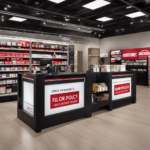






![Best Mop for Laminate Floors: Top Picks for Effective Cleaning [2024] 96 91MTQHTEgAL 1](https://byretreat.com/wp-content/uploads/2023/11/91MTQHTEgAL-1-80x80.jpg)








![Best Mop for Laminate Floors: Top Picks for Effective Cleaning [2024] 111 91MTQHTEgAL 1](https://byretreat.com/wp-content/uploads/2023/11/91MTQHTEgAL-1-400x240.jpg)

![Best Weed and Feed Products for a Lush Green Lawn [2024] 114 81hPWFaP6qL](https://byretreat.com/wp-content/uploads/2023/11/81hPWFaP6qL-80x80.jpg)
